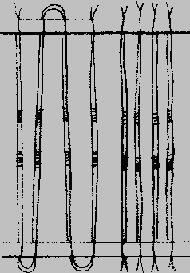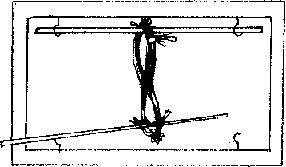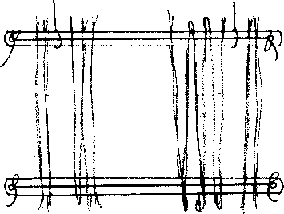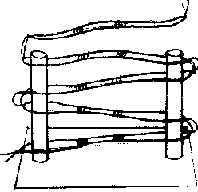
EARTH
GUILD
33 Haywood Street
Asheville NC
28801
GUILD
33 Haywood Street
Asheville NC
28801
technical help: 828-255-7818
for orders: 1-800-327-8448
fax: 828-255-8593
e-mail us at
inform@earthguild.com
| Earth
Guild Riffs (instruction sheets) |
TEXSOLV HEDDLES
| Texsolv heddles are made from a continuous double-strand
of fine, crocheted, heat-treated, white polyester cord. Two parallel
strands are joined (crocheted together, not knotted) at the top and
at the bottom of the heddle. Two sets of six very short crosspieces,
just above and below the center, form and reinforce the eye. There
are short lengths of cord between each two heddles, that become tails
if the heddles are cut apart (see diagram). They are very strong, knot-less, light-weight, resistant to fraying and to excessive stretching (they do have a little give, thanks to their crocheted or chain-linked structure). They slide easily along harnesses. They do not have to be tediously tied by human hands. Many sizes are available, in half-inch (12 mm) increments through-out the most useful range. Length is measured from top to bottom joins not counting the connectors. |

|
 |
Since there is some yield, most rigid harness
frames can be accommodated, but if you are designing or building a
loom, itís best to pick a heddle size at the outset. If your loom
has harness sticks (as is generally the case with countermarche looms),
the length of the heddle determines the working size of the harness.
They are packaged in sets of 100, secured with 4 twist-ties. DO NOT UNDO THE TIES UNTIL THE HEDDLES ARE ON THE HARNESS (should this happen, see the notes at the end). The color of the ties indicates the heddle length, but some colors are used more than once - check the list. To put texsolv heddles onto your loom, it may help to think of the the bundle as a single heddle (see diagram). If you want to end up with a partial 100 on a harness, put the full 100 on, then move some off (see below for details). |
| FOR LOOMS WITH RIGID HARNESS FRAMES |
|
| Jack looms typically have this kind of harness. Most of these have moveable bars or rods inside a rectangular frame. Hang the heddle-bunch from the top bar or rod, (see diagram. Set bar in place. Slide the bottom rod through the lower loop of the heddle bunch, being careful not to twist the bunch, and set that bar in place. The bundled bunch will be a little shorter then the separate heddles, so this can be a little awkward. But try not to succumb to the temptation to remove the ties too soon. |  |
| FOR LOOMS WITH HARNESS STICKS |
|
| Countermarche looms generally have horizontal harness sticks, not connected to each other, with no vertical side pieces. The heddles hang from the top stick, and the lower stick hangs from them. The length of the heddle determines the working height of the harness. With this set-up, it can be a little bit of a balancing act to get your heddles in place, as the bottom stick will want to topple until the heddles are spread out. A second set of hands can be helpful. Be sure to put on security ties (see diagram). Heddles can and often do go outside of the jack cords that hang the upper harness sticks. |  |
Once the heddles are in place, you can cut them apart - or not. Probably you will want to eventually, especially if they are to work widely spaced. And they do slide a little easier. If you want some of them on another harness, you of course will have to. If you do cut, be sure to do it between heddles, in the middle of the short lengths that connect one to the next, leaving equal tails, and not through heddles (see diagram at the top of the page).
If you donít want even hundreds on your harnesses, put a full bunch on, spread them out till you can count them, cut them apart if they aren't already (see above), slide the set to be moved back together and twist-tie them in the same four places; two above the eye and two below. You may want to do the same thing with the ones that will stay where they are. If you store a bunch of heddles off-loom, you or someone else will be glad later if you have attached a note that says how many there are. If there arenít too many, heddles that are extra for a particular project can live on the loom, out to the sides. Unused Texsolv heddles take up very little room on a harness.
Texsolv heddles are very light-weight. This is generally an advantage, especially for production weaving. It is less work to lift a harness-full of them, and if you are doing it thousands of times, this matters. But some jack looms rely on weight to make the harnesses drop after they have been lifted. If this becomes a problem, you may need to attach some extra weight. Some kind of metal strip secured to the bottom of the frame. Don't do it unless you have to.
Texsolv heddles are much quieter than metal ones. I canít think, off-hand, of a case where this would be a disadvantage.
| Should your heddles come unbundled too soon, and become one long snarl, it's not actually difficult to fix. Itís just tedious. You'll need to engineer some kind of jig with two pegs set a little closer together than the length of a heddle. Pieces of dowel set into a block, or just tied or clamped, will work, or even uprights from a couple of chair backs set at the right distance. Just wind the continuous heddle-string back and forth in a zig-zag (see diagram; this is far easier to draw or to do than to say), then re-secure them and pretend it never happened. |  |
© Earth Guild (You may reproduce this if it is unaltered and our name stays on it.)